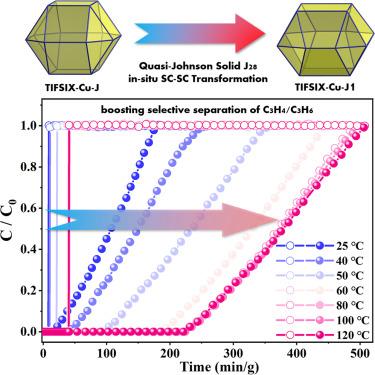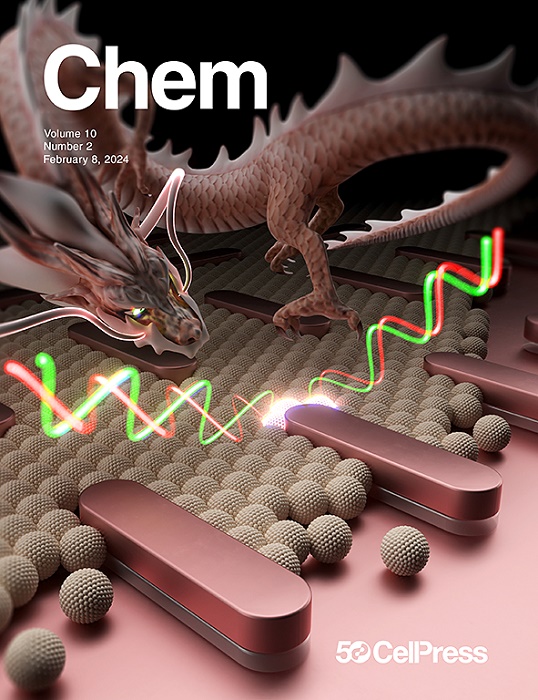Pillar-cage fluorinated hybrid porous frameworks featuring quasi-Johnson solid J28
IF 19.6
1区 化学
Q1 CHEMISTRY, MULTIDISCIPLINARY
引用次数: 0
Abstract
Adsorptive separation process based on porous materials is widely employed in various separation scenarios owing to its mild operating conditions and energy-efficient characteristics. In this study, we present a bottom-up, self-assembly approach to synthesize a novel pillar-cage fluorinated hybrid porous framework (TIFSIX-Cu-J), which exhibits a rare crystalline quasi-Johnson solid J28 structure. Notably, this material undergoes heat-triggered structural transformation, resulting in a new distorted square orthobicupola structure (TIFSIX-Cu-J1). The structural changes were elucidated through detailed analysis of the single-crystal-to-single-crystal transformation and bulk crystalline powder X-ray diffraction. The resulting framework demonstrates significantly enhanced performance in separating trace propyne from propylene. In situ breakthrough experiments show that the TIFSIX-Cu-J1-packed column can achieve approximately 20-fold higher C3H6 productivity (≥99.95%) compared with TIFSIX-Cu-J at 298 K and 1 bar. This study presents the first successful fabrication of crystalline square orthobicupola frameworks demonstrating in situ structural transformation characteristics, which exhibit significant potential for energy-efficient gas purification applications.

具有准约翰逊固体J28的柱笼式氟化混合多孔框架
基于多孔材料的吸附分离工艺以其操作条件温和、节能等特点被广泛应用于各种分离场合。在这项研究中,我们提出了一种自下而上的自组装方法来合成一种新型柱笼型氟化杂化多孔框架(tif6 - cu - j),该框架具有罕见的晶体准约翰逊固体J28结构。值得注意的是,这种材料经历了热触发的结构转变,产生了一种新的扭曲的方形正二元体结构(tif6 - cu - j1)。通过单晶向单晶转变和体晶粉末x射线衍射的详细分析,阐明了结构变化。结果表明,该框架在分离微量丙烯和丙烯方面的性能显著提高。原位突破实验表明,在298 K和1 bar条件下,tif6 - cu - j1填充柱的C3H6产率比tif6 - cu - j高出约20倍(≥99.95%)。本研究首次成功制备了方形正畸体晶体框架,展示了原位结构转化特性,在节能气体净化应用中表现出巨大的潜力。
本文章由计算机程序翻译,如有差异,请以英文原文为准。
求助全文
约1分钟内获得全文
求助全文
来源期刊

Chem
Environmental Science-Environmental Chemistry
CiteScore
32.40
自引率
1.30%
发文量
281
期刊介绍:
Chem, affiliated with Cell as its sister journal, serves as a platform for groundbreaking research and illustrates how fundamental inquiries in chemistry and its related fields can contribute to addressing future global challenges. It was established in 2016, and is currently edited by Robert Eagling.
 求助内容:
求助内容: 应助结果提醒方式:
应助结果提醒方式:


